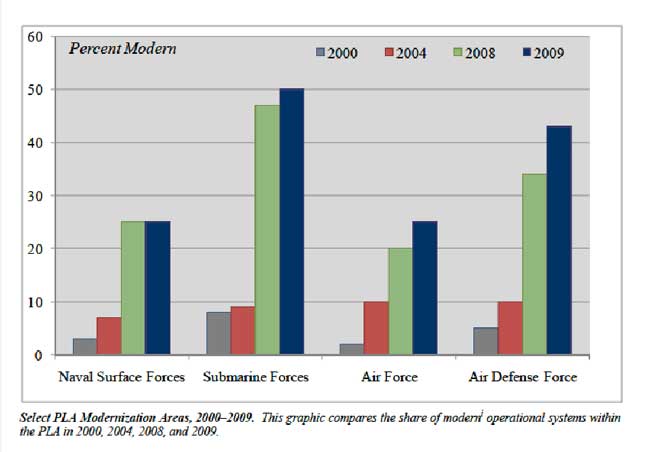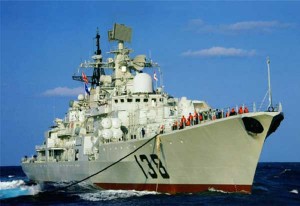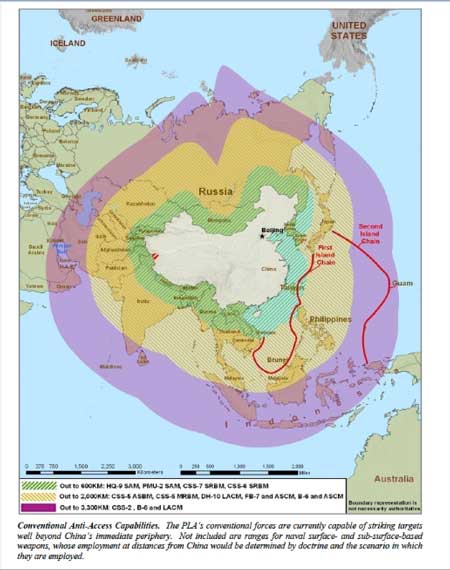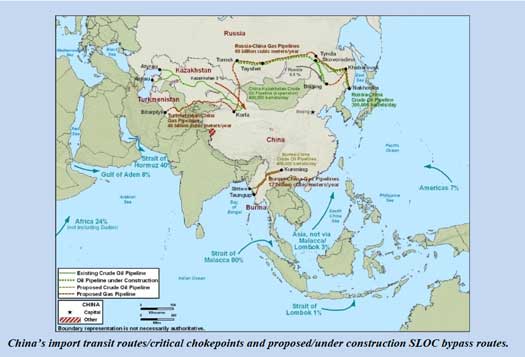 Type 022 (Houbei-class) fast-attack missile craft
Type 022 (Houbei-class) fast-attack missile craft
Credit Photo: http://www.sinodefence.com
Chinese Military Power Report Highlights Growing Chinese Naval Might
09/30/2010 – On August 17th, 2010 the U.S. Department of Defense released its latest edition of its annual assessment of China’s military capabilities, intentions, and behavior to the U.S. Congress.
Although the title of this year’s report has been changed from the previous “Military Power of the People’s Republic of China” to the more anodyne “Military and Security Developments Involving the People’s Republic of China 2010,” the report’s themes echo those found in previous editions. When one considers the recent reports collectively, one prominent theme is the growing strength of the Chinese Navy.
China’s maritime strategy has traditionally centered on countering threats posed by foreign powers to its coastal region. A more recent function of the People’s Liberation Army Navy (PLAN) is to defend the PRC’s claims in off-shore territorial disputes with maritime neighbors. PRC policymakers want to protect their access to off-shore fisheries and gain access to the energy resources under nearby Pacific waters, whose estimated value has soared in recent decades. As China has become a global trading nation increasingly dependent on overseas energy sources and other key imports, PRC leaders have likely become interested in protecting China’s maritime supply lines from pirates and other threats to their freedom of the seas.
Over time, the PRC’s sustained military buildup has allowed the PLAN to modernize many of its platforms and weapons systems. Since the late 1990s, China has begun revolutionizing its naval capabilities by undertaking an ambitious modernization program, producing approximately one hundred new warships since 2001. At its projected rate of expansion, the PLAN could possess more ships than the U.S. Navy at some point in the next decade or two. The qualitative improvement has been equally stunning. Successful introduction of anti-ship missile technology, near silent submarines, and Soviet-era radar and tracking technology has effectively turned what had been a primarily shore-defense Navy into a viable regional maritime power. These developments, along with parallel and anticipated future advancements, set the stage for the PLAN’s possible acquisition of blue-water power projection capacity.
A PLAN priority has been to enhance the capabilities of its submarine fleet. The dozen Russian-made Kilo-class diesel electric submarines, along with the indigenously built Song submarine class, acquired by the PLAN during the last two decades have represented a marked advance in the PRC’s undersea warfare capabilities. Most recently, the PLAN has acquired about a dozen indigenously made submarines whose capabilities are quite impressive compared with previous boats. The Jin-class SSBN (Type 094) is armed with 12 JL-2 ballistic missiles, with the theoretical range to hit targets in the western half of the United States from strike positions west of Hawaii. The Shang-class SSN (Type 093) nuclear-powered attack submarines and the Yuan-class SSN (Type 041 or Type 039A) diesel-powered attack submarines complement one another due to their diverging power systems. In addition, the PLAN has by now acquired over a dozen slightly less advanced Song-class SSN (Type 039 or Type 039/039G) attack submarines. Furthermore, the PLAN order of battle includes around 60 older diesel-electric submarines of varying caliber that serve in anti-submarine and anti-surface roles using the newest Sino-Russian torpedo and missile design technologies. Although many PLAN submarines are outdated, the newest classes are approaching the capabilities of those of the other major world navies in sound-dampening technology, naval propulsion, and weapons systems.
 Credit Graph: 2010 Annual Report to Congress on Military
Credit Graph: 2010 Annual Report to Congress on Military
and Security Developments Involving the People’s Republic of China
In addition to modernizing its fleet of submarines, the PLAN has developed increasingly sophisticated surface combatants. Since the early 1990s, the PLAN has put five new types of destroyers and frigates into service, with each successive model featuring new variations and improvements. Taken together, these modern warships are substantial improvements over China’s aging Luda (Type 051) destroyers that entered service in the 1970s and 1980s. Many of these new warships feature stealthy hull designs; efficient propulsion systems; and enhanced sensors, electronics, and weapons systems. blue sky ship.
During the 1990s, China purchased two Sovremenny class missile destroyers (DDG) from Russia. These outclassed any surface combatant fielded by the PLAN at the time, providing improved anti-submarine warfare capabilities; more advanced anti-ship missiles, and longer expected sea-duty time. Since the original purchase of these four Russian destroyers, the PRC has introduced its own improvements regarding both design and functionality to its indigenously made surface warships. At present, concurrent generations of indigenously manufactures destroyers, and to a lesser extent

frigates, have been increasingly more capable due to the longer reach of their platforms, improved active electronic countermeasures, advanced ASW helicopters, and newer generations of air defense and anti-ship cruise missiles. The Luzhou, the most current version of the Chinese destroyer, serves the role of a fleet air defense ship with the SA-N-20 missile system capable of engaging targets upwards of 150 km away utilizing an onboard radar guidance system. The slightly older Luyang-II missile destroyer features an indigenously developed radar system similar to the Aegis AN/SPY-1 used by the U.S. Navy, along with advanced anti-ship cruise missiles capable of engaging targets at a distance of 280 kilometers. Although it does not employ the SA-N-20 missile, the air defense capabilities on the Luyang II offer substantial improvements to earlier Chinese models and, coupled with some ASW capabilities through the use of an onboard all-weather ASW helicopter, provide the Chinese Navy with a solid foundation on which to build additional fleet support surface combatants.
The latest PLA-N destroyers, the Taizhou and Ningbo, were constructed in 2004. They offer more advanced on-board weapons systems than their predecessors. Again, though, only two ships were constructed, since the PLAN seems to be looking to combine the best ASW capabilities, fleet air defense, and anti-ship missiles all on one ship class. The latest versions of frigates, the Jiangkai I and II offer similar improvements as the Luyang or Luzhou class destroyers by employing the latest in conjoined radar and air defense technology. In addition, the Jiangkai II offers advanced sea-skimming anti-ship cruise missiles capable of engaging targets at 180 kilometers and an ASW helicopter.
Furthermore, the Chinese Navy has been developing a large number of smaller vessels, including littoral and coastal vessels, gunboats, missile boats, torpedo boats, amphibious craft, and mine warfare ships. These vessels can be used for a variety of missions, both offensively and defensively or in support of larger ships, though many of these vessels are for coastal combat only because of their limited range and size. The dozens of small Houbei-class (Type 022) fast-attack craft, armed with anti-ship cruise missiles and using stealthy catamaran hulls, might prove the most useful. They perform coastal patrol and defense missions, allowing larger ships to extend their operations elsewhere.
These new warships in both the frigate and destroyer classes offer significant improvements over the Navy’s designs of the 1970s and 1980s. The roles of these ships, that of air defense and power projection, provide the beginnings of what could become a fleet battle group. Most notably, though, is the absence in the PLAN order of battle of any cruisers or aircraft carriers. It is speculated that, when the PLA-N is comfortable with the improvements made to these smaller classes of ships, work will start on these vital but more complex elements of a blue-water fleet. The PLAN has already purchased from Ukraine the aircraft carrier Varyag, an uncompleted Soviet-era sloped-deck carrier. The expectation is that the Varyag will serve either as a training vessel or as a model for future carrier development.
 The potential reach of Chinese weapons
The potential reach of Chinese weapons
Credit Map: 2010 Annual Report to Congress
on Military and Security Developments
Involving the People’s Republic of China
The PLAN still lacks the sealift capacity to transfer and sustain a large expeditionary force for an extended period, though it is increasing its capabilities. China has effectively doubled its force of roughly 20 landing ship tanks (LSTs) by additionally building 10 Yuting-II and 10 Yubei-class LSTs from 2003 to 2005, each with a capacity to carry roughly 250 troops. The PLAN also maintains numerous smaller transports that augment the LSTs. In 2006, the Chinese Navy built a larger landing platform dock that can hold up to 800 troops and can provide greater mission flexibility. In total, the PLA-N can amphibiously transport a maximum of 15,000 troops in a single wave. China’s airlift capability is comparably modest, with a capacity to transport a maximum of 5,000 parachutists in a single operation.
In addition to its sea-based assets, the PLAN currently encompasses a ground-based air contingent, the PLA Naval Air Force (PLANAF), along with a small Marine Corps. Although Chinese warships have been making impressive gains, the PLAN’s air and ground elements have not kept pace. The PLANAF includes hundreds of older J-7E (a Mig-21 variant) and J-8II air superiority fighters along with the H-6D (based on the Soviet Tu-16 Badger), which carries two anti-ship missiles. The effectiveness of these planes against modern air defenses such as those found on U.S. Navy ships is questionable. The planes, weapons, and other technology found in the PLANAF lags considerably behind those of the more generously funded regular PLA Air Force.
Still, the PLA-NAF has received some newer generation Russian fighters purchased by the Chinese government, including Su-30s and Su-27s. The Su-30MK2 variant provided China has some advanced C4ISR capabilities along with a long-range search radar to detect surface ships to engage them with anti-ship missiles. The Su-30MK2 variant is generally compared to the U.S. F-15E fighter, though it still lags behind newer 5th generation aircraft such as the F-22 and F-35. In comparison, the SU-27 originally purchased from Russia was later copied to build a Chinese variant, the Shenyang J-11, which has undergone several modifications and technological improvements from the original Russian version. The J-11 offers improvements in radar and early warning systems, but most of these warplanes have gone to the regular Air Force. Perhaps the newer J-11s could be modified to serve as carrier-launched fighter planes when the PLAN proceeds with its expected aircraft carrier development. Until then, existing doctrine calls for the PLANAF to conduct primarily territorial water defense and fleet air support in those within reach of land-based warplanes.
The PLAN Marine Corps is a small contingent of highly trained troops that serve on China’s few amphibious transport dock ships, which are based at the Zhanjiang port attached to the South Sea Fleet. Numbering approximately 12,000 troops, the Marine Corps exists to provide the “first boots on the ground” during any sea based invasion, while also serving as garrison forces for islands under dispute yet controlled by the PRC. The Marine Corps equipment includes amphibious Type 63 and 63A tanks along with a variety of armored personnel carriers. These are all seriously outdated. Barring a significant investment in new equipment and larger numbers, the PLAN Marine Corps will continue to serve primarily as an instrument to garrison remote islands and board and fight pirate ships.
 (Credit Map: 2010 Annual Report to Congress on Military
(Credit Map: 2010 Annual Report to Congress on Military
and Security Developments Involving the People’s Republic of China)
As partial compensation for its weak marine air and ground components—two areas that could be important should Beijing ever try to invade Taiwan—the PLA has developed a powerful strike capability in its large number of long-range missiles. They give the PRC the capacity to deter U.S. support for Taiwan as well as to improve its ability to project military power in Asia. The PLA has positioned more than one thousand short-range ballistic missiles opposite Taiwan to menace the island—periodically reinforcing this stockpile with a smattering of medium-range ballistic missiles and land-attack cruise missiles. The PLAN has also acquired a variety of indigenous and foreign-made anti-ship cruise missiles. Among the most powerful are Russian-made SS-N-22 Sunburn missiles carried aboard China’s Sovremenny-class destroyers and SS-N-27 Sizzler missiles found aboard some of China’s twelve Kilo-class attack submarines. Of special concern to the U.S. Navy is China’s ongoing effort to develop an anti-ship ballistic missile based on the DF-21. With a sought-after range of more than 1,500 km (900 miles), the PLAN’s wants to have a missile that would allow the PLA to strike deep into the western Pacific. The missile is also to be equipped with a maneuverable re-entry vehicle that would allow its warhead to target moving ships and a warhead sufficiently powerful to disable or sink an aircraft carrier. One important reason that missile technology is they would help compensate for the inferiority of China’s conventional air power in a clash with the United States.
Notwithstanding the rapid modernization of the Chinese military, a significant technological gap continues to exist between the PRC and the United States in almost all important areas of military power. In addition to the continued existence of a disparity between the two nations in terms of air, naval and missile technology, China lags even farther behind the United States in other important areas, such as the capacity to organize joint operations; command and control communications systems; military computers; surveillance and reconnaissance; and precision strikes. The PLA’s ability to sustain force at a distance remains limited, which means that China is still a regional rather than a global military power. How long this favorable balance will persist in the face of the PRC’s sustained buildup of its military power is anyone’s guess.

